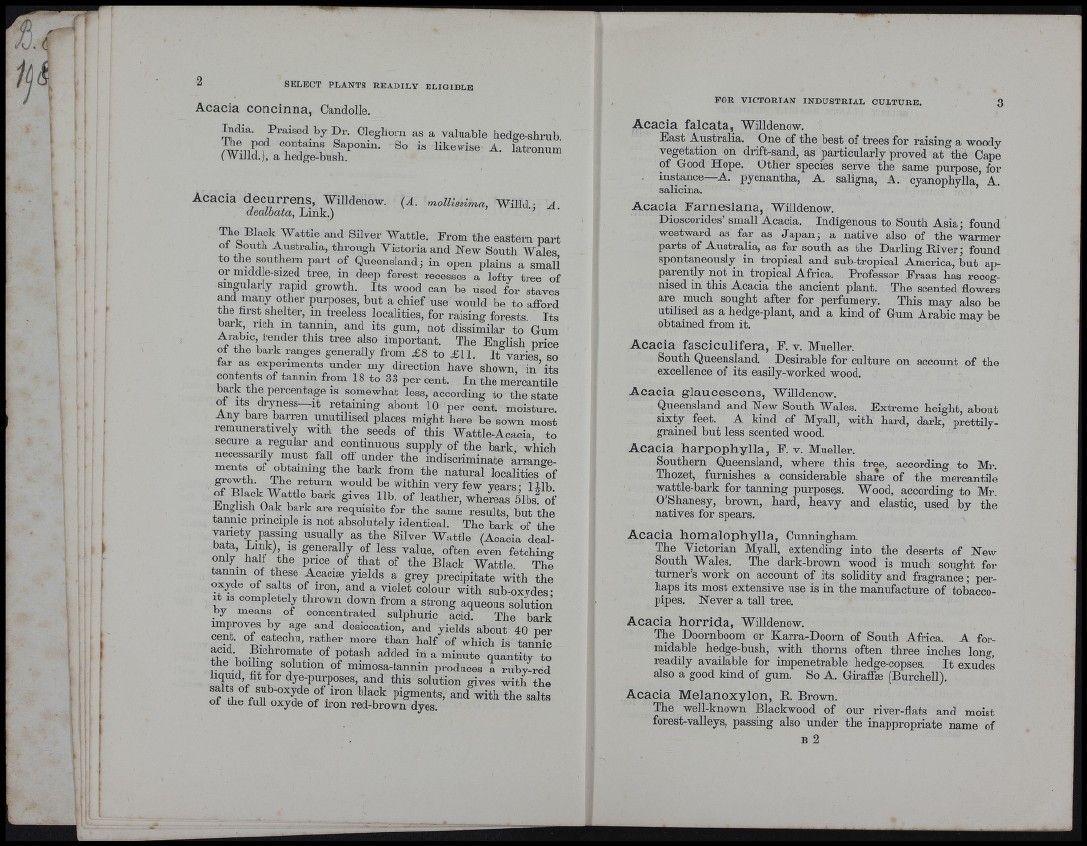
Acacia concinna, Candolle.
India. Praised by Dr. Clegliorn as a valuable hedge-shrub.
T L Y So is (WiJld.), a nedge-busli. Ukewise A. latronum
Acacia decurrens, Willdenow. (A. mollissima, Willd • A
dealbata, Link.)
The Black Wattle and Silver Wattle. From the eastern part
ot South Australia, through Victoria and New South Wales
to the southern part of Queensland; in open plains a smali
or middle-sized tree, in deep forest recesses a lofty tree of
singularly rapid growth. Its wood can be used for staves
and many other purposes, but a chief use would be to afford
the hrst shelter, m treeless localities, for raising forests. Its
barl^_ rich in tannin, and its gum, not dissimilar to Gum
Arabic, render this tree also important. The English price
of the bark ranges generally from £ 8 to £11. I t varies so
iar as experiments under my direction have shown, in ’its
contents of tannin from 18 to 33 per cent. In the mercantile
bark the percentage is somewhat less, according to the state
of Its dryness—It retaining about 10 per cent, moisture.
Any bare barren imiitilised places might here be sown most
remuneratively with the seeds of this Wattle-Acacia, to
secure a regular and continuous supply of the bark which
necessarily must_ fall off under the indiscriminate ¿rrange-
ments of obtaining the bark from the natural localities of
growth. The return would be within very few vears- lU b
of ^ t t l e bark gives Hb. of leather, whereas 51bs! of
English Oak bark are requisite for the same results, but the
tannic principle is not absolutely identical. The bark of the
variety passing usually as the Silver Wattle (Acacia deal-
bata, Link) IS generally of less value, often even fetching
only_ half the price of th a t of the Black Wattle. The
tannin of these Acaciae yields a grey precipitate with the
oxyde of salts of iron, and a violet colour with sub-oxvdes;
It IS completely thrown down from a strong aqueous solution
by means of concentrated sulphuric acid. The hark
improves by age and desiccation, and yields about 40 per
cent, of catechu rather more than half of which is tannic
acid. Bichromate of potash added in a minute quantity to
mimosa-tannin produces a ruby-red
liquid, fit for dye-purposes and this solution gives with the
ooif tthheff fnullll oxyde of iron red-browping mdyeenst.s, and with the salts
FOR VICTORIAN INDUSTRIAL CULTURE. 3
Acacia falcata, Willdenow.
East Australia. One of the best of trees for raising a woody
vegetation on drift-sand, as particularly proved at the Cape
of Good Hope. Other species serve the same purpose, for
instance A. pycnantha, A. saligna, A. cyanophylla A.
salicina. ’
Acacia Farnesiana, Willdenow.
Dioscorides’ small Acacia. Indigenous to South Asia; found
westward as far as Japan; a native also of the warmer
parts of Australia, as far south as the Darling Biver; found
spontaneously in tropical and sub-tropical America, but apparently
not in tropical Africa. Professor Fraas has recognised
in this Acacia the ancient plant. The scented flowers
are much sought after for perfumery. This may also be
utilised as a hedge-plant, and a kind of Gum Arabic may be
obtained from it.
Acacia fasciculifera, F. v. Mueller.
South Queensland. Desirable for culture on account of the
excellence of its easily-worked wood.
Acacia glaucescens, Willdenow.
Queensland and New South Wales. Extreme height, about
sixty feet. A kind of Myall, with hard, dark, prettüy-
grained but less scented wood.
Acacia harpophylla, F. v. Mueller.
Southern Queensland, where this tree, according to Mr.
Thozet, furnishes a considerable share of the mercantile
wattle-bark for tanning purposes. Wood, according to Mr.
O’Shanesy, brown, hard, heavy and elastic, used by the
natives for spears.
Acacia homalophylla, Cunningham.
The Victorian Myall, extending into the deserts of New
South Wales. The dark-brown wood is much sought for
turner’s work on account of its solidity and fragrance; perhaps
its most extensive use is in the manufacture of tobacco-
pipes. Never a tall tree.
Acacia hórrida, Willdenow.
The Doornboom or Karra-Doorn of South Africa. A formidable
hedge-busb, with thorns often three inches long,
readily available for impenetrable hedge-copses. I t exudes
also a good kind of gum. So A. Giraffse (Burchell).
Acacia Melanoxylon, R. Brown.
The well-known Blackwood of our river-flats and moist
forest-valleys, passing also under the inappropriate name of
B 2